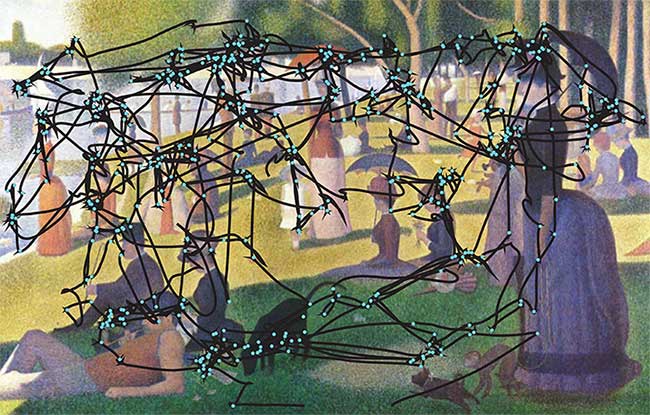This 'rice-powered machine' is a thousand times better than the most professional camera
Because there is no "predictive" capacity like the brain, the camera will pick up everything, including the slightest vibration movement of the hand held by the camera.
The picture below, " A Sunday afternoon on La Grande Jatte Island" was painted in 1884 by French artist Georges Seurat. Black lines are not the work of a mischievous child, but of neuroscientist Robert Wurtz of the American National Eye Institute.
Ten years ago, he asked his colleagues to look at the picture while wearing a contact lens that records eye movement. The eye line becomes these black lines.

The painting "A Sunday afternoon on La Grande Jatte island".
Impressionism in painting was inspired by scientific research on how we see things. Hermann von Helmholtz, a German physician, physicist and philosopher, author of the 1987 book "Optical Handbook - Physiology" , gave us an understanding of how people perceive dimension. depth, color and movement.
One of the questions Helmholtz wondered, and perhaps Seurat, too, is why we keep our eyes moving constantly to see our surroundings, but most of the images we see are "static" and fine. clear, clear?
The power of the brain
Look at the black lines on the picture, they were created in just three minutes. If a digital camera records all of that movement with the speed of movement of the human eye, the film will become blurry.
Begin to learn from how the eyes of the recipient perceive the image and how we handle that information.
Basically, light from the surrounding will enter the retina. Here, photovoltaic cells begin to turn light signals into electrical signals, and put them into neurons to handle shapes, colors, angles, motion, contrast . The signals This effect is then inserted into the visual cortex to make cognitive decisions.
In fact, only a small area of the retina is called an eye hole as a function to receive image information. Therefore, to see all things in the environment, people move their eyes around many times and very quickly in a second. Then this information is "assembled" by the brain into a panorama.
"Saccade" is the term used to call that action. Saccade is driven by what we are paying attention to, although we often do not realize we are doing so.

The basic structure of the eye shows the location of the fovea.The saccade eye roll action allows different parts of a scene to be reclaimed by the eye.(Photo: CancerresearchUK).
There are many reasons why the extremely fast movements of the eyes do not make the image we see become blurry. One of them is that sometimes the brain ignores certain information. It tends to ignore objects that are blurred, only record clear object information.
In other words, the brain deceives us, so we see everything clearly. In fact, the image obtained from the eyes is so blurry that it is hard to see anything.
The next reason explains why our image is so stable, it does not vibrate like when shooting a camera. That's because the brain has the function of "reproducing" the scene by putting together many small photos, then making predictions about things, impending movements.
"See" before "looking"
The quick eye movement is actually just to verify if the brain is predictably correct. That means we "see" before actually "looking" with our eyes.
Information from the eyes only to verify the picture that the brain "draws" before. If there are no errors, the picture remains stable and we see that everything around is "static" therefore.
Cameras do not have a "predictive" function, so they will pick up everything, including the slightest vibration of the hands of the person holding the camera, so we see the image vibrating. As for humans, the brain has been shaken by human intellect.
Scientists have actually measured a signal from the brain to the eye, ordered the eye to move and acquire information where it wanted. This has validated this hypothesis.
In addition, the brain takes 50-100 milliseconds to handle eye movements, so if something happens faster than that, we will be confused and ignored, not catching up. That is also the limit of the eye.
However, ignoring information from the eyes of the brain is considered an advantage for us to be less confused in the huge pile of information that the eye receives, and helps the brain not overload.
- Farmers 'demonstration' products at the science market
- Unexpected record of cotton of thousand grains
- Camera 'terrible' sensor up to 50 megapixels
- Fabrication of rice smoking machines by aerodynamic methods
- The 200-gauge radar camera technology is as small as a fingernail
- Rice transplanters
- 'Engineer' in the African field
- The ultra-small machine lifts objects 165 times the mass
- Improved threshing machine moves across all terrain
- Mechanic fabricates rice harvesters from waste products
- World's Fastest Camera: Capturing both chemical reactions
- Thanh Hoa: two farmers make rice transplanters
 'Fine laughs' - Scary and painful torture in ancient times
'Fine laughs' - Scary and painful torture in ancient times The sequence of numbers 142857 of the Egyptian pyramids is known as the strangest number in the world - Why?
The sequence of numbers 142857 of the Egyptian pyramids is known as the strangest number in the world - Why? History of the iron
History of the iron What is alum?
What is alum?